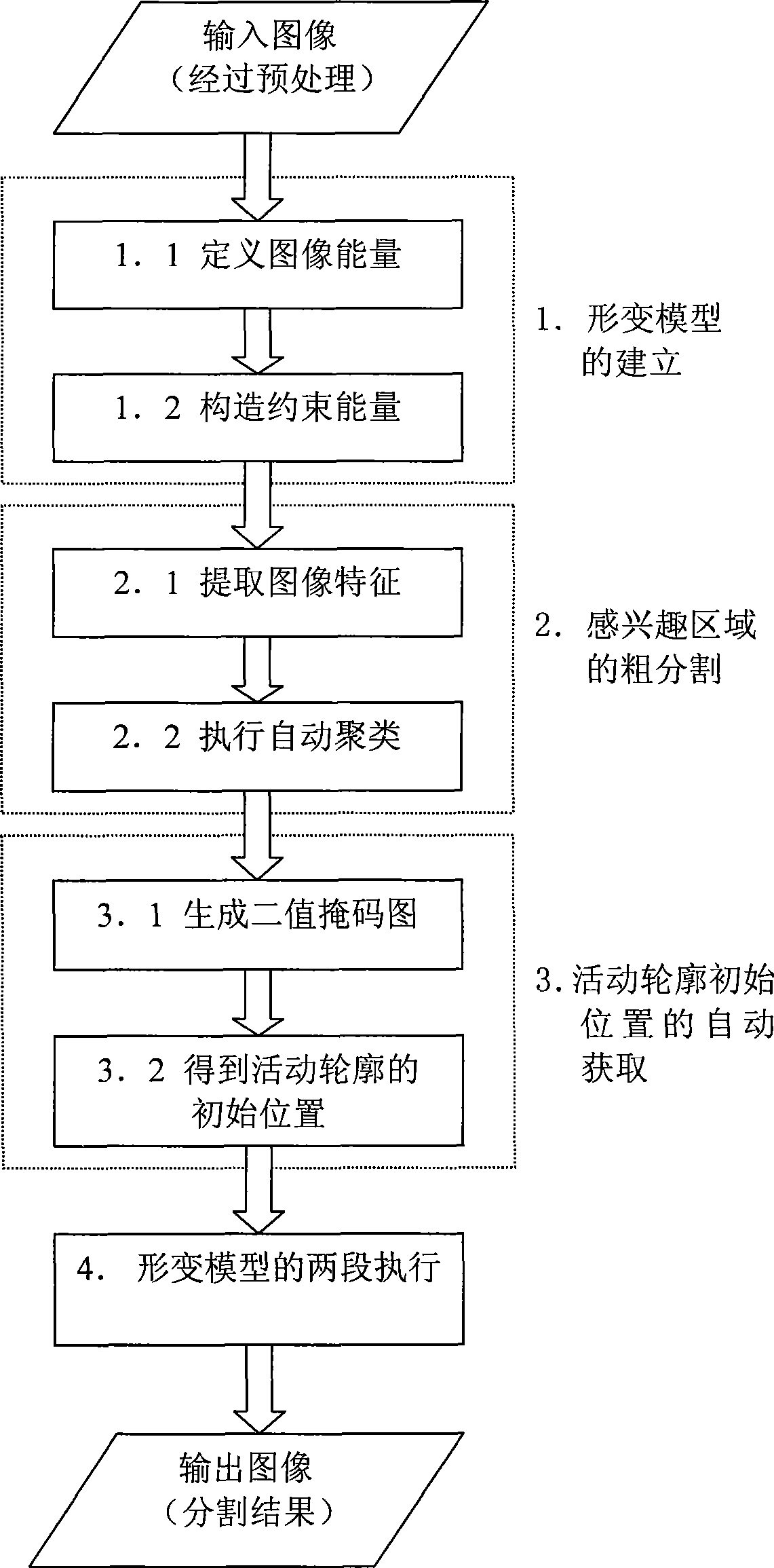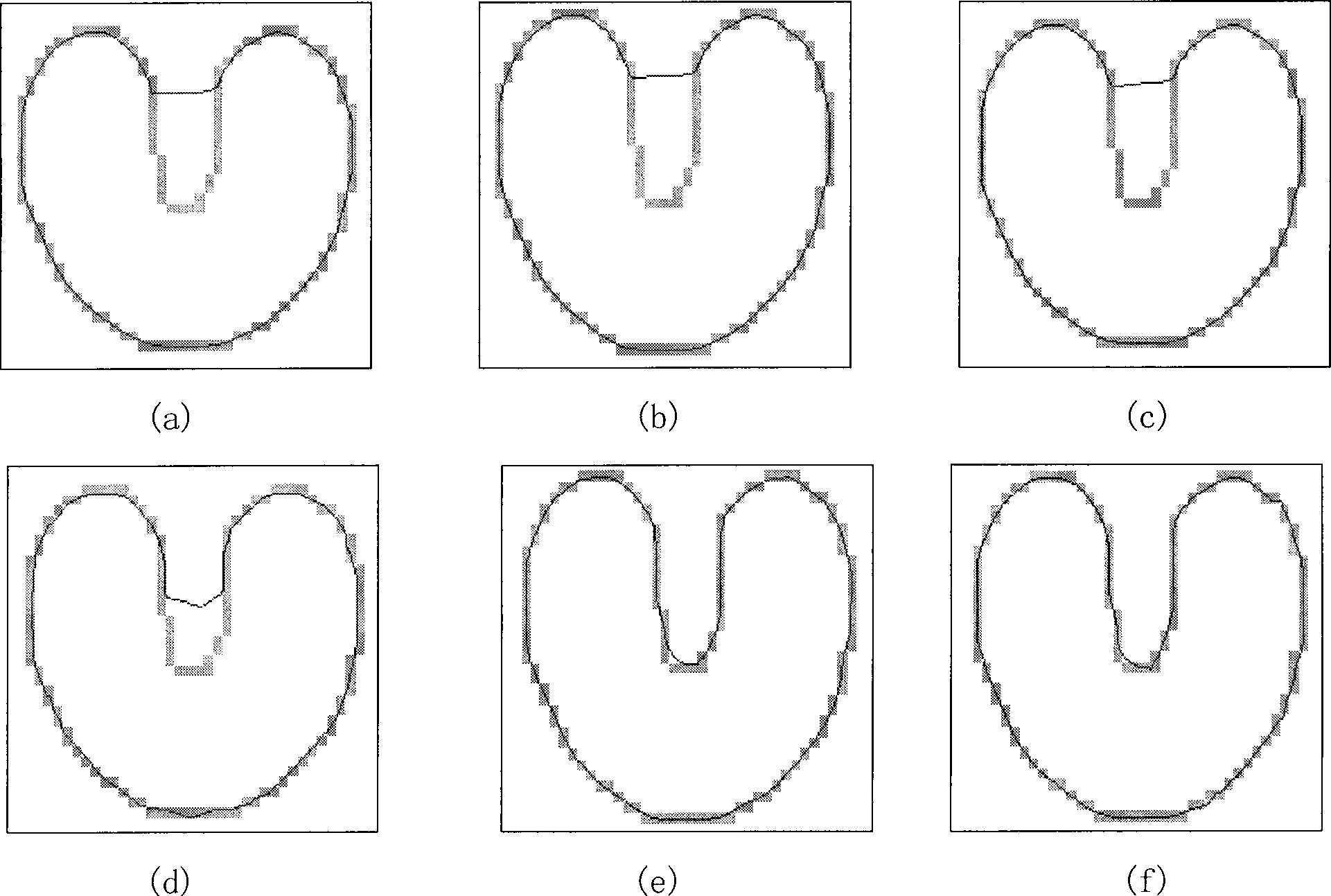Method for partitioning interested areas in WEB image
A region of interest and image technology, applied in the field of image processing, can solve the problems of local extreme point interference, large dependence on the initial position of the active contour, and correct segmentation of the concave boundary, so as to improve the segmentation accuracy and reduce the overall execution time. Effect
- Summary
- Abstract
- Description
- Claims
- Application Information
AI Technical Summary
Problems solved by technology
Method used
Image
Examples
Embodiment 1
[0108] Example 1: figure 2 Compare the segmentation results of objects in the recessed area for various deformation models. Image size
[0109] It is 64×64. ((a) Traditional deformation model (α=1, β=0.2, γ=10, δ=0) (200 iterations); (b) Balloon force model (α=1, β=0.2, γ=10, δ =0.05) (200 iterations); (c) distance potential energy model (α=0.05, β=0, γ=0.5, δ=0) (200 iterations); (d) GVF model (α=0.05, β= 0, γ=1, δ=0.5) (200 iterations); (e) the improved model in the present invention (α=1, β=0.2, γ=10, δ=4) (180 iterations); (f ) The two-stage execution strategy of the improved model in the present invention (α=1, β=0.2, γ=10, δ=0; δ=4) (140 iterations)).
[0110] The weight selection of each energy item in the deformation model not only considers the unification between different models, but also tries to ensure that each model can obtain a better boundary segmentation effect within the specified number of iterations, so the final weight determination is implemented It is cont...
Embodiment 2
[0111] Example 2: image 3 Compare the segmentation results of the region of interest in the image for various deformation models (275 iterations). The image comes from the Corel image library, and the image size is 100×100. ((a) Original image; (b) Traditional deformation model (α=1, β=0, γ=6, δ=0); (c) Balloon force model (α=0.6, β=0, γ=2, δ=0.15); (d) Distance potential energy model (α=0.05, β=0, γ=0.5, δ=0); (e) is a model that uses only the restraint energy generated from the inner gravitational force of a triangle (α=1, β=0, γ=8, δ=3); (f) is the deformation model adopting two-stage execution strategy in the present invention (α=1, β=0, γ=6, δ=0; δ=3)) .
[0112] In this embodiment, the initial position of the active contour is obtained by drawing a circle. The chromaticity gradient is used to form the chromaticity contour of the region of interest in the image (the "flower area in the center of the image"). From image 3 It can be seen that since the boundary of the region ...
Embodiment 3
[0113] Example 3: Figure 4 In order to compare the segmentation results of the region of interest in the image by the deformation model proposed in the present invention when different image sub-blocks are taken (the number of iterations: the first segment is 100; the second segment is 50). (The original image is the same as in Example 2; (a) sub-block size = 2×2 cluster; (b) sub-block size = 4×4 cluster; (c) sub-block size=5×5 cluster ; (D) is the segmentation result corresponding to (a); (e) is the segmentation result corresponding to (b)); (f) is the segmentation result corresponding to (c); (α=1, β=0, γ=6, δ=0; δ=3)).
[0114] In this embodiment, the initial position of the active contour is obtained by automatic clustering. From Figure 4 It can be seen that although the clustering results are not the same in the three cases ((a) obtains better clustering results than (b) and (c)), after using the deformation model of the two-stage strategy, the same The segmentation results ...
PUM
 Login to View More
Login to View More Abstract
Description
Claims
Application Information
 Login to View More
Login to View More - R&D
- Intellectual Property
- Life Sciences
- Materials
- Tech Scout
- Unparalleled Data Quality
- Higher Quality Content
- 60% Fewer Hallucinations
Browse by: Latest US Patents, China's latest patents, Technical Efficacy Thesaurus, Application Domain, Technology Topic, Popular Technical Reports.
© 2025 PatSnap. All rights reserved.Legal|Privacy policy|Modern Slavery Act Transparency Statement|Sitemap|About US| Contact US: help@patsnap.com



